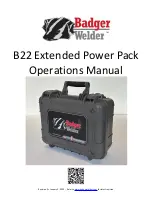
18
| English
1 609 92A 09K | (14.6.13)
Bosch Power Tools
Connecting the Dust Extraction
Place a vacuum hose
6
(accessory) onto the vacuum connec-
tion
7
. Connect the vacuum hose
6
with a vacuum cleaner (ac-
cessory). An overview for the connection of various vacuum
cleaners can be found at the end of these instructions.
To enable optimum dust extraction, use the splinter guard
20
if possible.
The vacuum cleaner must be suitable for the material being
worked.
When vacuuming dry dust that is especially detrimental to
health or carcinogenic, use a special vacuum cleaner.
Operation
Operating Modes
Before any work on the machine itself (e. g. mainte-
nance, tool change, etc.) as well as during transport
and storage, remove the battery from the power tool.
There is danger of injury when unintentionally actuating
the On/Off switch.
Orbital Action Settings
The four orbital action settings allow for optimal adaptation of
cutting speed, cutting capacity and cutting pattern to the ma-
terial being sawed.
The orbital action can be adjusted with the adjusting lever
10
,
even during operation.
The optimal orbital action setting for the respective applica-
tion can be determined through practical testing. The follow-
ing recommendations apply:
– Select a lower orbital action setting (or switch it off) for a
finer and cleaner cutting edge.
– For thin materials such as sheet metal, switch the orbital
action off.
– For hard materials such as steel, work with low orbital ac-
tion.
– For soft materials and when sawing in the direction of the
grain, work with maximum orbital action.
Adjusting the Cutting Angle (see figure I)
The base plate
9
can be swivelled by 45° to the left or right for
mitre cuts.
– Remove the dust cover
11
and the vacuum connection
7
.
– Pull the saw blade storage
8
out of the base plate
9
.
– Loosen the screw
23
and lightly slide the base plate
9
to-
ward the vacuum connection
7
.
– For adjustment of precise mitre angles, the base plate has
adjustment notches on the left and right at 0°, 22.5° and
45°. Swivel the base plate
9
to the desired position ac-
cording to the scale
22
. Other mitre angles can be adjusted
using a protractor.
– Afterwards, push the base plate
9
to the stop in the direc-
tion of the saw blade
14
.
– Tighten the screw
23
again.
The dust cover
11
, vacuum connection
7
and splinter guard
20
cannot be used for mitre cuts.
Cut Control for Bevel Cuts (see figure J)
For cutting-line control of bevel cuts, the “Cut Control” view-
ing window
15
has a mark
24
for 0° right-angle cuts and a
mark
25
each for the left- or rightward sloping 45° bevel cut
according to scale
22
.
The cutting mark for bevel cuts between 0° and 45° results
proportionally. It can additionally be drawn on the “Cut Con-
trol” viewing window
15
with a non-permanent marker, and
easily be removed again.
For accurate working, it is best to carry out a test cut.
Offsetting the Base Plate (see figure I)
For sawing close to edges, the base plate
9
can be offset to
the rear.
Loosen the screw
23
and slide the base plate
9
toward the
vacuum connection
7
to the stop.
Tighten the screw
23
again.
Sawing with the base plate
9
offset is possible only at a 0°
bevel angle. Additionally, “Cut Control” may not be used to-
gether with the base
13
, the parallel guide with circle cutter
27
(accessory), as well as the splinter guard
20
.
Starting Operation
Inserting the battery
Use only original Bosch lithium ion batteries with the
voltage listed on the nameplate of your power tool.
Using
other batteries can lead to injuries and pose a fire hazard.
Switching On and Off
To
start
the machine,
first
push the lock-off button for the
On/Off switch
1
and
then
press the On/Off switch
2
and keep
it pressed.
The power light
18
lights up when the On/Off switch
2
is
slightly or completely pressed, and allows the work area to be
illuminated when lighting conditions are insufficient.
To
switch off
the machine, release the On/Off switch
2
.
Note:
For safety reasons, the On/Off switch
2
cannot be
locked; it must remain pressed during the entire operation.
Controlling the Stroke Rate
Increasing or reducing the pressure on the On/Off switch
2
ena-
bles stepless stroke-rate control of the switched-on machine.
Light pressure on the On/Off switch
2
results in a low stroke
rate. Increasing the pressure also increases the stroke rate.
The required stroke rate is dependent on the material and the
working conditions and can be determined by a practical trial.
Reducing the stroke rate is recommended when the saw
blade engages in the material as well as when sawing plastic
and aluminium.
After longer periods of work at low stroke rate, the machine
can heat up considerably. Remove the saw blade from the ma-
chine and allow the machine to cool down by running it for
approx. 3 minutes at maximum stroke rate.
No orbital action
Small orbital action
Medium orbital action
Large orbital action
OBJ_BUCH-1204-002.book Page 18 Friday, June 14, 2013 2:03 PM
















































